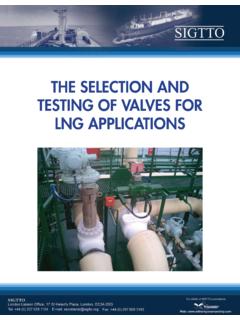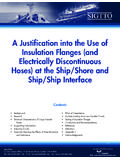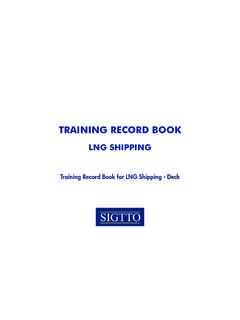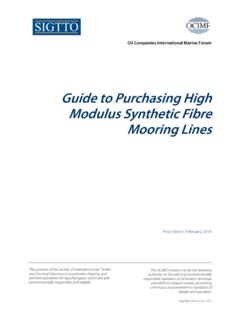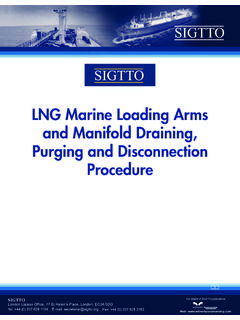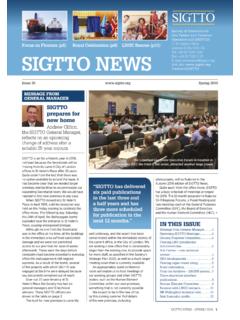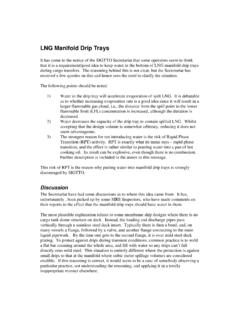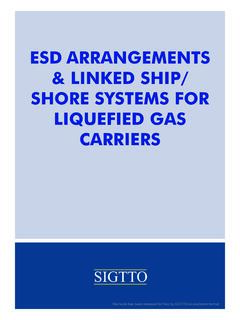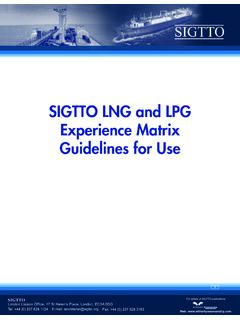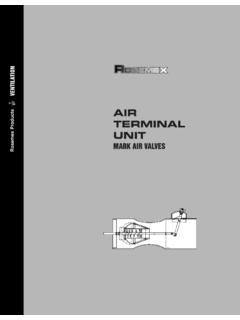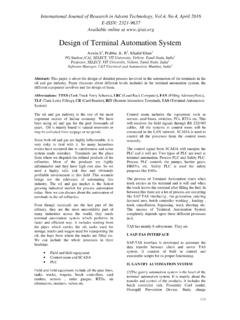Transcription of Guide for PlanninG GaS TrialS for lnG VeSSelS - …
1 Guide for PlanninG GaS TrialS for lnG VeSSelSConTenTS IntroductIon PurPose of Gas TrialS delIvery condItIon of the vessel onboard testInG of carGo handlInG equIPment cold testInG wIth ln2 Pre-Gas TrialS PreParatIon Gas TrialS Glossary Guide for PlanninG GaS TrialS for lnG VeSSelSintroductionthe term Gas TrialS is used to encompass those tests that are undertaken during a period when a quantity of lnG is taken onboard for testing shipboard facilities at, or near to, the design temperature. Gas t rials are usually carried out prior to the vessel entering service in order to confirm the correct function, integrity and capacity of the complete cargo system, including containment, insulation, cargo handling equipment, pipelines and valves and the equipment to handle boil-off gas (boG).
2 This document is intended to provide members of sIGtto some guidance on the requirements for testing the systems for handling the lnG cargo, and its consequential boG, using lnG loaded onto a vessel specifically for that purpose. the scope is considered applicable for established membrane, spherical tank and sPb designs. however, it does not extend to novel or prototype designs, which may require specific additional testing. this document is not intended to be used as an operational procedure, but merely as an aide to preparing a specification for gas guidance aims to cover those items tested prior to the handover of a vessel and also the testing carried out post delivery.
3 When a first full cargo has been figures provided in the text are only indicative and reference should be made to the shipbuilder and manufacturer s information for figures applicable to a specific underlying assumption in this document is that the Gas t rials are conducted by the shipbuilder prior to delivery of the vessel. this is the common practice for lnG ships, but by no means exclusive (note, the normal practice in the lPG industry appears to be for the TrialS to be conducted at the first load port after delivery). Gas t rials Guide for lnG VeSSelS , sname 1977 is an informative reference often cited in lnG shipbuilding of Gas TrialsGas t rials are performed primarily for confirmation of the correct operation of the lnG and gas handling systems, which cannot otherwise be factory tested, and for verification of the correct operation of the equipment and systems that will be used for containment and custody transfer measurement of the lnG testing should usually include the gas management system, the monitoring control and alarm systems for the lnG tanks and liquid pumps, valve operation, the gas compressors.
4 Heat exchangers, gas combustion units (G cu ) and reliquefaction plant, if provided. w here applicable, dual or tri fuel engines should usually also be included in the test programme in their respective gas burning generated during gas TrialS may be used either as fuel burnt in boilers or multi-fuel engines, sent to the Gcu, or reliquefied and returned to the cargo tanks, as applicable. the vapour may also be returned ashore while the vessel is alongside the lnG terminal if this facility is of excess boG may be dealt with through steam dumping or thermal oxidising in a Gcu. venting of natural gas to atmosphere, other than to test the vent system operation, should not be included as part of Gas t rials procedure and it is suggested that it should only take place if unavoidable through equipment failure or emergency function of the entire system should be confirmed as being in compliance with the requirements of the classification society, the flag a dministration.
5 The particular ship-building specification for the vessel and any other criteria that may is usual that the performance testing of cargo pumps and compressors is carried out at the manufacturer s facility prior to delivery to the shipyard, to ensure that the equipment meets the specification requirements and to facilitate accuracy of the recording of calibrated measurements. the operational testing of this equipment at full capacity during Gas t rials is therefore not usually intended to prove that the performance meets the contractual the calibration and testing of cargo temperature, level sensor and pressure measuring devices used for custody transfer purposes, is usually carried out at the equipment manufacturer s facility in the presence of a third party surveyor, prior to their installation on the vessel.
6 Delivery Condition of the Vessela major consideration in the PlanninG of the Gas TrialS may be the condition in which the vessel is to be delivered to the owner after completion of Gas t contractual arrangements require the vessel to be delivered in a gas-free condition then any liquid remaining onboard on completion of Gas TrialS will need to be discharged ashore, necessitating a second visit to the selected lnG terminal. thereafter, cargo tank warm-up, inerting and aeration will have to be contractual and commercial arrangements allow for delivery of the vessel with the cargo tanks in gassed up condition and/or with residual lnG remaining on board, then a second visit to the terminal for discharge of residual liquid may not be required.
7 However the gassed-up condition will usually preclude the return of the vessel to the shipyard for any remaining works to be undertaken and certain post trial options, such as the internal inspection of the cargo tanks, will not be an owner require the cargo tanks to be subjected to a complete thermal cycle, for example cooling the tanks until the secondary membrane is reduced to -100 c in all regions, this will usually result in an extended period alongside the lnG terminal and a significant increase in the quantity of lnG required for the Gas t rials. It is recommended that, in these cases, the requirements are discussed with the shipyard at an early stage and details included in the contractual arrangements for vessel delivery.
8 Prior to Gas Trialsbefore Gas t rials can be carried out, it is to be expected that the shipyard s confirmation that the cargo containment and cargo handling systems are completed is required. to include: completion of the cargo containment system onboard testing of cargo equipment cold testing (with ln2)Completion of the Cargo Containment SystemIrrespective of the type of containment system selected, the inspection and testing of the cargo tank components will usually be undertaken in fabrication shops and onboard the vessel throughout its tanks, on completion of construction, will usually have been strength and leak tested, at ambient temperature, in accordance with classification society and flag administration requ tests are usually carried out on membrane tanks after the repair of any leakage found during the appropriate ambient temperature testing programme for the particular tank design.
9 A tightness test of the secondary barrier of the membrane tank systems is usually carried out after completion of the construction of the containment system. a pressure differential between the primary and secondary insulation spaces is usually established by use of vacuum pumps to create a vacuum in the secondary space. the variation of pressure difference against time is recorded and a vacuum decay curve plotted to summarise the results. the data obtained during this test provides a reference for comparison with periodic testing at intervals during the service life of the cleaning and final inspection of cargo tanks, to ensure removal of all equipment and debris, is then carried out.
10 After which the tank lids are immediately secured to prevent unauthorised entry and possible far as practical, it is suggested that an internal inspection of the cargo lines is carried out to ensure that there is no debris left those systems with glued secondary barriers, ie Gtt mark III and cs-1, there is presently an additional requirement under Imo resolution (25) to conduct further secondary barrier tightness tests after the initial cool down in accordance with the approved procedures of the system Testing of Cargo Handling equipmentPrior to testing any items of equipment it is suggested that all relevant alarms and safety devices should be confirmed as is also recommended that, as a minimum, the following items are included in the onboard testing programme: confirmation of cargo pump and spray pump installation, including checks to ensure correct pump rotation on start up.
